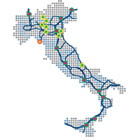Interest rate risk
Fluctuations in interest rates affect the market value of a company’s financial assets and liabilities as well as its net financial expense. Snam aims to minimise interest rate risk while pursuing financial structure objectives laid down in its business plans.
The interest rates of some of Snam’s loans are indexed to benchmark rates, notably the Euro Interbank Offered Rate (Euribor). In order to limit interest rate risk, Snam uses derivative financial instruments – notably interest rate swaps (IRSs) – to manage the balance between fixed-rate and floating-rate debt. The IRSs implemented in this case convert floating-rate debt into fixed-rate debt.
The fair value of derivative financial instruments, which is the estimated amount that Snam would be expected to pay or receive to terminate the agreements at the end of the accounting period, is systematically calculated on the basis of market prices provided by specialist information providers. Snam does not have derivative contracts held for trading or speculative purposes.
As described in the section “Liquidity risk”, Snam currently raises funds solely through its ultimate parent, Eni S.p.A. Should Eni S.p.A. sell its controlling stake in Snam, there is no guarantee that the latter would be able to obtain loans and financing from other sources under the same conditions as those currently in force.
Natural gas price risk
Up to the end of the second regulatory period on 31 December 2009, the transportation costs incurred for the acquisition of gas needed to operate the compression stations were included in overall operating costs and therefore updated using the price-cap29 mechanism. As of the start of the third regulatory period on 1 January 2010, the Electricity and Gas Authority, enacting the new tariff criteria laid down by Resolution ARG/gas 184/09, has defined methods for payment in kind, by shippers to transporters, of gas volumes to cover fuel gas, network losses and Unaccounted-For Gas, owed as a percentage of the volumes respectively injected into and withdrawn from the transportation network. As a result of these measures, and taking into account the mechanism for allocating gas to shippers, change in the price of natural gas for covering fuel gas no longer represents a risk factor for Snam. Price fluctuation risk remains from excess quantities of Unaccounted-For Gas and network losses withdrawn vis-à-vis the quantities paid for in kind by shippers.
29 Under this mechanism, core revenue components relating to operating costs, amortisation and depreciation are updated with financial statement figures at the start of a regulatory period, while they are updated with inflation and reduced by a productivity coefficient in the subsequent years.



